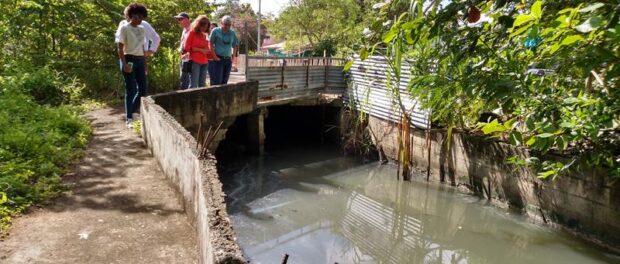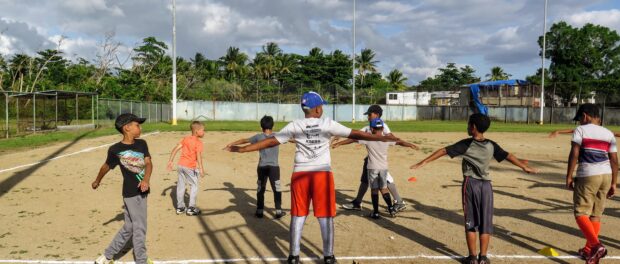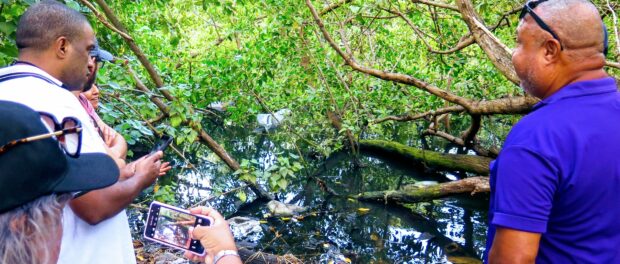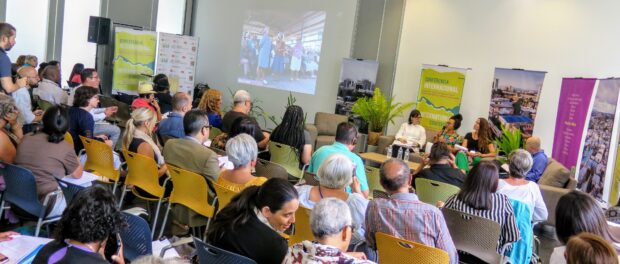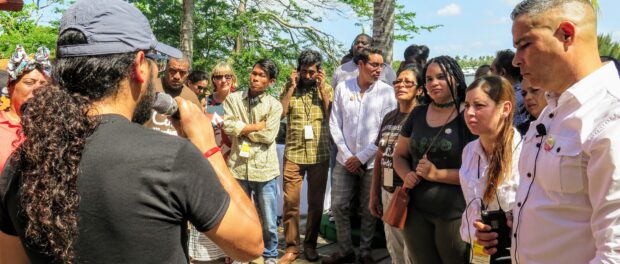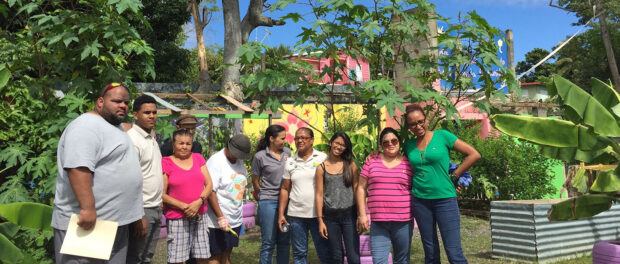
In celebration of the 50th anniversary of New Communities Inc., the world’s first Community Land Trust, and as planners and community members alike gather to celebrate October 2-5 at the Reclaiming Vacant Properties Conference 2019 in Atlanta, Georgia, RioOnWatch issued a call for articles highlighting the current growth of the CLT movement worldwide. Contributors wrote in from around the world, with stories about the expansion of CLTs—both in number and in approach—in Mississippi, the United Kingdom, Belgium, France, Puerto Rico, Rio de Janeiro, and Florida. This varied series aims to disseminate news of the successes of the CLT model as it adapts to new times and circumstances, bringing greater attention to this innovative solution to guarantee the right to housing and community development, and its potential in resolving the global housing crisis.
Today’s piece, co-authored by Patricia Basile, PhD in Constructed Environment from UVA and an independent scholar in Albuquerque, New Mexico, and Priscilla Mayrink, Architecture and Urbanism professor at FAP-CE, Faculdade Paraíso do Ceará, describes the widespread recognition attained by the Caño Martín Peña Community Land Trust in Puerto Rico.
For more information on CLTs and their potential for Rio de Janeiro’s favelas click here for text and here for video. For more information on the history of the Caño Martín Peña CLT, click here and here.
In the early 2000s, the informal settlements lining the Caño Martín Peña Canal in downtown San Juan, Puerto Rico, were among the first in the world to organize and establish a Community Land Trust to fight gentrification and the displacement of residents. Since its implementation, the Caño Martín Peña Community Land Trust has received significant international attention, using this recognition strategically to tell their story and share the CLT model with other informal settlements around the world.
An area with a history of removal and relocation threats, the eight neighborhoods surrounding the Martín Peña Canal are today home to some 25,000 residents. Though residents enjoy some measure of infrastructure —access to running water, paved roads, and electricity—many houses still suffer from flooding and improper sanitation services. The combination of these factors creates a major risk for families, as canal flooding inundates the community with highly contaminated water.
The communities surrounding the canal thus responded favorably when the government proposed a canal dredging project in the early 2000s. Residents worried, however, that they would be displaced from the area if the dredging of the canal were to take place. They had prior experience with eviction threats. And they know that their communities, originally settled before development in the area, are now located on land in central San Juan next to the financial district and thus prone to gentrification. The dredging process would raise land values, making the area highly attractive to developers.
In response to resident resistance, the technical team in charge of the dredging works held a series of meetings with residents, where said concerns were voiced, as were the possibilities for addressing the risk via public policy. The goal was to ensure that the dredging could be undertaken without threatening families with eviction. What began as an infrastructure project for the canal became a broad local development plan, leading to the creation of the Caño Martín Peña CLT, or Fideicomiso de la Tierra, along with the ENLACE project and the Group of Eight Communities (G-8).
From 2002 to 2004, the Caño CLT was established to regularize ownership of land and protect the Caño’s low-income residents from eviction and gentrification. The process of community organization brought about a new law that recognized the G-8 as an organization that represents the eight communities, as well as creating the ENLACE project—a public, limited-term company to implement the District Development Plan elaborated by the community, using public resources and in partnership with residents—and officially recognizing and transferring land ownership to the Caño Martín Peña CLT. The creation of the CLT altered the ownership of the land on which the communities are located: public lands fell under the ownership of the Caño CLT, which is managed by residents collectively and now administers their lands. Thus, they have removed the lands for perpetuity from the speculative real estate market. The Caño CLT includes 2,000 low-income families (not all families in the neighborhoods participate), who gained access to housing through the regularization of surface rights on top of their collective lands, thanks to concentrated collective mobilization.
International Recognition
Over ten years after their founding and once their CLT model had established its success, the Caño CLT received the World Habitat Award in 2015. Organized by the World Habitat international charity in partnership with UN-Habitat, the award highlights innovative and replicable housing solutions across the world, and includes both a £10,000 prize and the opportunity to share recipient experiences with organizations from seven different countries in a peer exchange event. This was one of the first opportunities the Caño CLT group had to share their model with other housing initiatives around the world.
Speaking to NBC News, UN Special Rapporteur Leilani Fahra explained why the Caño CLT won the award, saying “The project tackles a number of core elements for the right to housing, such as ensuring security of tenure for those living in informal settlements, community participation, and protection of land… It recognizes housing is a human right rather than a commodity. Women are community leaders, and the project ensures them title to properties.”
Also on NBC, Lyvia N. Rodríguez Del Valle, the CLT’s executive director at the time, commented on the importance of the award for their community. “Having this recognition means so much for the humble communities of San Juan,” said Del Valle. “It’s a chance to call attention to what is happening here and to finally continue to encourage the support that our communities need to achieve the environmental healing of the channel and to address the problem of public health that is affecting our people.”
The award was celebrated in 2016 at the Habitat III Conference in Ecuador when representatives of the Caño Martín Peña CLT had the opportunity to present the project, including their successes, challenges, and impact, as well as answer questions from the audience. It was there that EPA officials and others, including a Catalytic Communities* collaborator, had the opportunity to learn about the Caño CLT first hand, resulting in a first article about the history and mode of operation of the Caño CLT here on RioOnWatch. This article was later republished in Progressive City. The Caño CLT success has been reported and praised widely by international news outlets such as Rolling Stone, Next City, The Guardian, and numerous others.
In 2017, the Caño CLT was one of six finalists of the Buckminster Fuller Award, which calls attention to initiatives that are creatively addressing the world’s most pressing issues. The Buckminster Fuller Institute considered the Caño CLT to be truly revolutionary, inspiring other communities in Brazil, Ecuador, Paraguay, Peru, and South Africa to pursue similar paths. That same year, the Caño CLT applied with Catalytic Communities to the Lincoln Institute of Land Policy, to investigate the potential of the Canõ model in the Rio de Janeiro context. Successful in their application, the partners investigated the legal structures available to or limiting the application of CLTs in Brazil, and led a peer exchange event in 2018, which led to the Rio de Janeiro CLT Working Group.
Efforts to Spread the Model
In 2018, the Caño CLT was one of ten initiatives selected for the Communities Thrive Challenge grant. Sponsored by the Rockefeller Foundation and the Chan Zuckerberg Initiative, the grant includes $1 million and technical assistance to scale and share solutions with as many people as possible. The project was selected through a peer-review process based on its impact on the lives of community members, the potential for scale and replication, the degree to which the community was involved in the development of the project, and the commitment of project leadership to represent their community.
Receiving this grant has been an important achievement for the Caño CLT. Given that a critical component of the grant involves sharing experiences and expertise with other informal settlements around the world—especially those suffering from similar conditions of lack of infrastructure, environmental injustices, and threats of gentrification and eviction—the reception marks a decisive step for efforts to spread the Caño CLT model globally.
In addition, in April 2019 the Ford Foundation funded a 16-nation peer exchange event and international public conference in Puerto Rico hosted by the Caño CLT, with the participation of groups and community leaders from countries including Argentina, Bangladesh, Barbuda, Belize, Brazil, Ecuador, Indonesia, Mexico, and South Africa. Among others, community members and leaders of a long-term displacement camp in Bangladesh had the opportunity to see the Caño CLT up close, learning about their process of implementation and what the CLT model can achieve in terms of community empowerment, housing affordability, and security. Bangladeshi participant Imran Ali would later describe what he learned, telling the Global Land Alliance:
“The lessons I will take back to Bangladesh include:
-
- Community unity is most important;
- Through the CLT, people living on vulnerable (e.g. flood-prone) land can be relocated to appropriate and secure housing;
- CLTs enable the regularization of land tenure;
- CLTs guarantee long-term affordability and avoiding displacement;
- The situation of my community is similar to the other communities [I met from] different parts of the world.”
This group and other informal settlements from around the world are inspired by Caño, and have begun considering the CLT model for their own communities as a way to achieve better and more secure housing conditions. The Caño’s exchanges also contribute to the development and strengthening of a network of experts, activists, and leaders who are committed to achieving housing justice around the world, bringing attention to the CLT model and its potential in achieving just and affordable housing.
Greg Rosenberg, a CLT movement veteran and co-director of the Center for CLT Innovation is quick to point out that “in terms of having an impact with the CLT model, informal settlements are where we could have the most impact globally, and on a massive scale.”
This is the fifth article in our series on the growth of the global CLT movement. Click here for more.
*Catalytic Communities is the nonprofit organization that publishes RioOnWatch.

